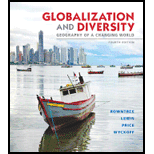
The way in which three tropical bioregions differ and the reason for their difference.
Answer to Problem 1RQ
The difference between the tropical rainforests, tropical seasonal forests, and tropical savanna corresponds primarily to precipitation. All the three bioregions are located within the tropics, and contain fairly high and constant temperatures. However, they differ in the amount of precipitation and seasonality. The tropical rainforests receive abundant rainfall annually, the tropical seasonal bioregions have a distinct dry season, and the tropical savannas receive considerably less rainfall.
Explanation of Solution
Bioregions are the assemblage of local flora and fauna and closely correlated to the climate regions. The major characters of a climatic region such as precipitation, temperature, and seasonality are some of the factors that influence the distribution of the collection of plants and animals involving a specific bioregion. Bioregions are the ecologically and geographically defined area. The bioregions containing tropical climates are tropical rainforest, tropical savanna, and tropical seasonal forest. All these bioregions are located in the tropical zone of the Earth.
Tropical Rain Forests: The tropical rain forests are located along the equator in the Af climate region. It is characterized by copious sunlight, high average annual temperatures, and ample rainfall occurring throughout the year. It covers about 7 percent of the world’s land area and more than half of the world’s known flora and fauna species that live in this bioregion, which makes it the most diverse of all the bioregions.
The common rainfall amounts range from
Tropical Seasonal Forests: The tropical seasonal forests are found on the north and south of the equator bracketing the true tropical rain forest. It has an Am or monsoonal climatic region. The tropical seasonal forest is an intermediate climate between the tropical rainforest climate and tropical savanna climate. It contains a distinct dry season but it is short and typically lasts for four months. Owing to the seasonal droughts, rainfall is only about half of the amount found in the true rain forest. As a result, the region will be an open landscape with trees which are spaced farther apart when compared to the true rainforest which has the annual rainfall.
In addition, the seasonal rain forest trees are deciduous trees that shed their leaves during the dry season to slow their growth or hibernate until the rain returns. With a distinct dry season, this bioregion is subjected to wildfires caused by both natural and human-set.
Tropical Savannas: The tropical savanna bioregions are found in the Aw climate region, which has a pronounced dry season that lasts for six months of a year or longer. The dry season can be severe with the flora and fauna adapting to the drought conditions. The tropical savanna ecosystem is less dense than the true tropical rainforest because it has adapted to less rainfall during only during particular period of year.. As a result, the vegetation of these equatorial areas is often sparse with widely spaced trees in a landscape dominated by grassland. The common annual rainfall amounts are around
Want to see more full solutions like this?
Chapter 2 Solutions
Globalization and Diversity: Geography of a Changing World
 Applications and Investigations in Earth Science ...Earth ScienceISBN:9780134746241Author:Edward J. Tarbuck, Frederick K. Lutgens, Dennis G. TasaPublisher:PEARSON
Applications and Investigations in Earth Science ...Earth ScienceISBN:9780134746241Author:Edward J. Tarbuck, Frederick K. Lutgens, Dennis G. TasaPublisher:PEARSON Exercises for Weather & Climate (9th Edition)Earth ScienceISBN:9780134041360Author:Greg CarbonePublisher:PEARSON
Exercises for Weather & Climate (9th Edition)Earth ScienceISBN:9780134041360Author:Greg CarbonePublisher:PEARSON Environmental ScienceEarth ScienceISBN:9781260153125Author:William P Cunningham Prof., Mary Ann Cunningham ProfessorPublisher:McGraw-Hill Education
Environmental ScienceEarth ScienceISBN:9781260153125Author:William P Cunningham Prof., Mary Ann Cunningham ProfessorPublisher:McGraw-Hill Education Earth Science (15th Edition)Earth ScienceISBN:9780134543536Author:Edward J. Tarbuck, Frederick K. Lutgens, Dennis G. TasaPublisher:PEARSON
Earth Science (15th Edition)Earth ScienceISBN:9780134543536Author:Edward J. Tarbuck, Frederick K. Lutgens, Dennis G. TasaPublisher:PEARSON Environmental Science (MindTap Course List)Earth ScienceISBN:9781337569613Author:G. Tyler Miller, Scott SpoolmanPublisher:Cengage Learning
Environmental Science (MindTap Course List)Earth ScienceISBN:9781337569613Author:G. Tyler Miller, Scott SpoolmanPublisher:Cengage Learning Physical GeologyEarth ScienceISBN:9781259916823Author:Plummer, Charles C., CARLSON, Diane H., Hammersley, LisaPublisher:Mcgraw-hill Education,
Physical GeologyEarth ScienceISBN:9781259916823Author:Plummer, Charles C., CARLSON, Diane H., Hammersley, LisaPublisher:Mcgraw-hill Education,





